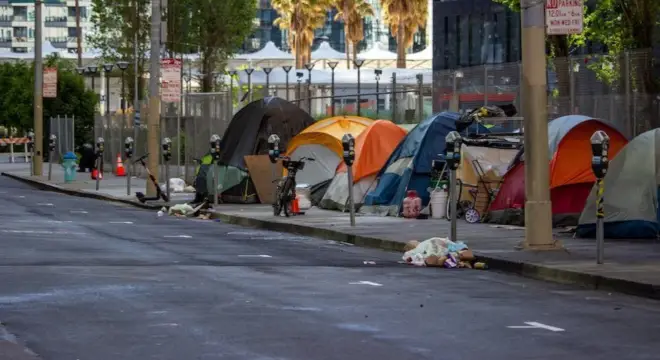Despite More Shelter Beds, Homelessness in San Francisco Continues to Grow
If San Francisco has so many shelter beds, why are people still sleeping on the streets? Why is the city’s homeless population growing even though shelters are almost always full? Is offering a bed enough—or is there something much deeper at play? And what’s really stopping the city from turning the tide?
Over the past several years, San Francisco has expanded its shelter system more than most major cities in the U.S. But despite the increased capacity, homelessness continues to rise, and tents still line sidewalks across the city. Clearly, the issue goes beyond just the number of available beds.
Let’s take a closer look at what’s really going on—and why this crisis isn’t going away.
2. A Growing Shelter System That’s Still Not Enough
San Francisco has increased its shelter system over the past five years by about 28% to accommodate rising interest. Compared to other U.S. cities, San Francisco has more shelter beds per capita than Los Angeles and Chicago. Only New York City, Boston, and Washington D.C. have more beds.
Despite this increase, nearly every bed in San Francisco is filled each night. Demand exceeds supply, and, it is clear that adding shelter beds is not keeping up with increasing demand.
3. The Harsh Reality: Homelessness Keeps Rising
Though there are now more shelter beds available than ever, homelessness in San Francisco is escalating at alarming levels. Since 2021, the city’s number of unhoused residents has increased by 43%, a jump that shelters alone aren’t able to address.
Currently, almost double the amount of homeless individuals compared to available shelter beds still remain. Tent cities and transient encampments, including people sleeping on storefront sidewalks, continue to be highly visible across the city. This continues to serve as proof that infrastructure in itself is not challenging the foundational causes of homelessness.
4. What’s Going Wrong Behind the Scenes?
At first glance, maybe San Francisco is doing everything right, increasing the number of shelter beds—but things are more complicated. The city has prioritized temporary shelter (with little success towards permanent housing efforts or affordable, ongoing housing programs).
Shelters and housing centers face major staffing shortages (thus limiting the number of people they can serve), and city leaders do not have the complete authority to oversee how areas surrounding shelter centers operate, making it difficult to create a safe, clean, and appropriate area.
Ultimately, the system is attempting to help—but overwhelmed, under-resourced, and not easy access to a system that addresses the problem at its base.

5. The Gap Between City Promises and Street-Level Reality
San Francisco’s Department of Homelessness and Supportive Housing has implemented numerous initiatives to address homelessness from increased shelter access to funding transitional housing programs. Logically, it makes sense. However, practically, it’s clearly not working.
The nonprofit organizations—many of which the city is relying on to implement this plan—don’t have the capacity to handle what is being asked of them. Workers are overwhelmed, resources are limited, and waitlists are increasing. Therefore, service providers and unhoused people are equally disappointed.
There is great potential for the city’s vision to address homelessness, but the reality of the day-to-day operations lay bare a system struggling to catch up.
6. Future Plans and Ongoing Challenges
San Francisco has announced plans to add 1,500 more shelter beds to help alleviate the pressure, but the real question remains: will that be enough? Even with this increase, the gap between demand and supply will still be significant.
The bigger issue here is whether shelter alone can truly solve the homelessness crisis. While more beds provide immediate relief, they don’t address the root causes—such as affordable housing shortages, mental health services, and job opportunities—that keep people on the streets.
In reality, San Francisco’s long-term strategies seem to be falling short. Temporary fixes like expanding shelter beds might help in the short term, but without a broader, more sustainable approach, the problem is unlikely to improve in the long run.
7. Public Reaction and Accountability
San Francisco’s response to increasing homelessness continues to be met with criticism from community members and advocacy groups alike. Many feel frustrated that they’re seeing little progress in the city’s response to homelessness and even less dedication to the underlying issues of homelessness beyond the provision of temporary shelter.
Residents as well, also feel frustration. The high a price tag the city carries for their homelessness service-often in the millions-doesn’t hide the reality that homelessness is starkly visible, often we see tents and encampments lining our sidewalks. For many, all of these resources aren’t enough.
There is a clear call for accountability on how public funds are spent and for change that will be tangible, long-lasting, and actually address the underlying homeless crisis.
8. Conclusion
San Francisco’s shelters are some of the most sophisticated in the nation, but that also doesn’t solve the problem of homelessness. We can’t forget that some of the reasons people are experiencing homelessness include the lack of affordable housing and mental health care, and job opportunities. We can expect these numbers to keep climbing. Can we actually think of shelter as a solution? It’s a short-term remedy, but it’s not an answer. It’s time for a more holistic and long-term view of these issues.
We need to take action now—further delays will only make it harder to turn back.


